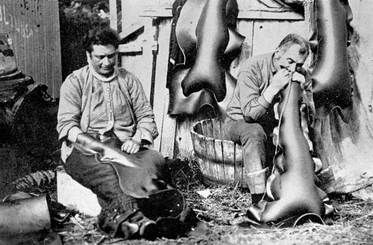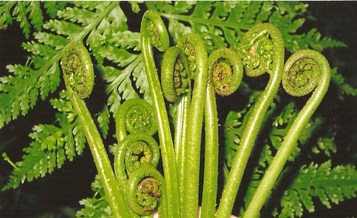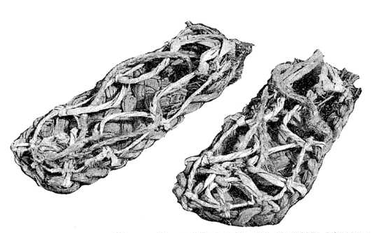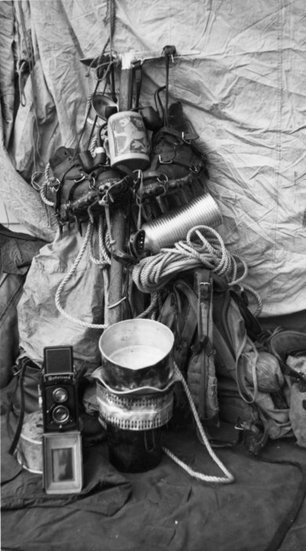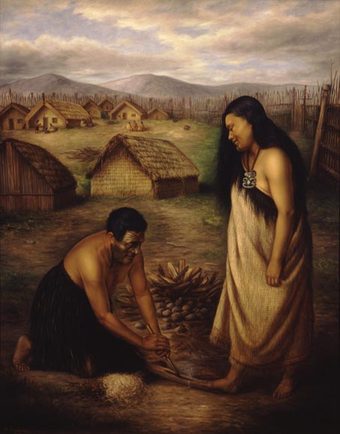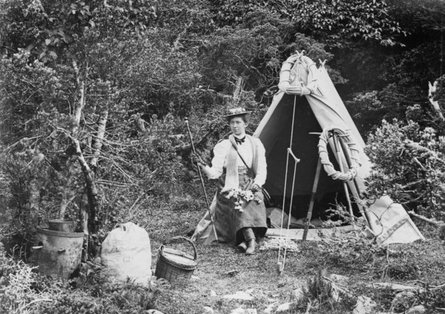Gear talk
|
With all the reading I've been doing to prepare for this epic journey I explored the explorers. I got to thinking about the gear and food they carried, compared to what we carry now.
PROVISIONS For Maori a transalpine journey meant gathering birds and packing them in kelp bags along with dried tuna (eel) and inanga (whitebait). Totara and kahikatea berries added variety to the fern roots and dried Mamaku (black fern). Along the way, there were fresh eels, ferns, gull eggs and live birds. Tender supplejack shoots are edible, as are bracken fern roots. Pikopiko the koru of a local hen and chicken fern, can be be steamed like bush asparagus but I have been told they need serious cooking. There are 7 edible ferns in NZ out of 312 species so you'll need to do your homework. European explorers lived on tea, flour damper and preserved meat, as well as birds and eels. During Brunner and Heaphy's epic 1846 trek from Nelson down the west coast, they carried 75lbs (35kg) each: flour, sugar, tea, coffee, ham half a bottle of whisky, a double barrelled gun and powder, a tin saucepan, an axe, a small tent, clothing and blankets "At lake Rotoroa they found a canoe, caught eels as they travelled, ate damper, pigeon and made a great haul of pigeon, blue duck, eel and weka". - Explorers and Travellers Charlie Douglas wrote a lot about his favourite birds and how his dogs provided a steady supply of Kiwi, Whio and Kakapo for meals. I'm not sure if Maori ate Whio. In David Young's book Whio he says some iwi considered Whio sacred, a mokai (pet) or kaitiaki (guardian). Te whio noho awa, noho kainga, he mokai na Ngaitai CLOTHES Maori travelled light weight and practical. In a flax cloak to let the rain run off and nothing down below except for sandals (paraerae) or sandal leggings (rohe wa). Paraerae, sometimes called snow sandals, were made of plaited flax, ti kouka (cabbage tree leaves) or mountain grass. Depending on the terrain they lasted from 1-5 days travel. The explorers wrote how their guides would camp at places with good food and sandal resources. They had to continuously renew sandal supplies and everyone pitched in. Sensible eh? When Leonard Harper and Locke crossed the alps in 1857 Locke persisted in wearing his permanently sodden leather boots and suffered badly swollen feet. Harper took up his maori guides' practice of flax sandals. Maybe flax Tevas are the way to go? Want to have a go? Check this out. Many early European explorers describe their clothes of wool and linen being utterly torn to shreds after a few weeks of cross country travel. Leonard Harper says they tied the remains of their shirts around them like an apron to provide modesty in the absence of trousers. Alpine speargrass and matagouri are particularly wicked : A P Harper wrote “The only stuff I know which is impervious to the stiff pointed ends of the stunted vegetation, is " Gabardine," made by T. Burberry and Son, Basingstoke, England.” Douglas describes sitting “maori style” naked under a blanket while his river-saturated woolen clothes are drying over the fire. Imagine how long it would take to dry woolen trousers. FIRE STARTING Friction from sticks made fire, (most of us tried this out at school or scouts). You need a piece of soft wood (Mahoe) on which you rub a piece of something hard (kaikomako) until you have smoldering, then add dry moss or ferns. THE PACK: AKA THE SWAG The swag tied it all together to carry. Backpacks were invented much later. In Erewhon Samuel Butler's hero made his swag. “Accordingly, I took as many biscuits as I thought I could carry, and also some tobacco, tea, and a few matches. I rolled all these things (together with a flask nearly full of brandy..) inside my blankets, and strapped them very tightly, making the whole into a long roll of some seven feet in length and six inches in diameter. Then I tied the two ends together, and put the whole round my neck and over one shoulder. This is the easiest way of carrying a heavy swag, for one can rest one’s self by shifting the burden from one shoulder to the other. I strapped my pannikin and a small axe about my waist, and thus equipped began to ascend the valley,” TENTS Harper describes Charlie Douglas' “batwing tent. He had an ingenious system of half a tent, hung beneath a canvas fly. The fly covered the tent and the area in front giving shelter for the the fire and cooking. Even some room to dry out clothes. Ferns and bracken could be built up around the side for more shelter. PHOTOGRAPHY Arthur P Harper introduced Charlie Douglas to photography during their 1890's surveying work. For each year’s work .. Douglas and I ...took sixteen dozen half plates, four dozen quarter plates and my two cameras- making a total of 60lbs. (27kg) The plates were changed at night time and when exposed were repacked in their boxes and left under sheltered rocks, to be picked up as we returned down the river…I developed and printed the whole lot when back in Hokitika. I did not take a tripod, having made a gadget which fixed the camera on my ice-axe. An ultralite gadget in 1884! |
